started earlier this week but lost two days due to an outbreak of a sporadically recurring back pain. Anyway, now that has decided to disappear, I have been typing overtime.
We are now heading towards July, but it is raining and cold. A good time to sort cards, and other things; and to check those wants lists before the autumn fairs start up. On which note, I took a bus, two trains, and a bus to Chiswick Car Boot Sale last Sunday, and met someone selling cigarette and trade cards. Never expected that! Anyway I will go again, its on the 6th of July, from 6 am until 12.30pm, and admission is £1.
This time the newsletter was not too hard to construct, I changed a few events midstream, lack of cards, lack of evidence, wrong dates, but most are as i wrote down originally. And they start with...

Duc de MONTEBELLO [trade : champagne : O/S - Mareuil sur Ay, France] "Advertising Card" (????) 1/1
Let us start by raising a glass to #NationalBubblyDay.
Now "bubbly" actually means any sparking beverage, but it seems fitting to go right to the top and have champagne. This card is actually for a champagne maker as well, and what`s more it shows the act of it squirting forth through the narrow bottle neck. However this is a recent invention, the first drinks from the Champagne region of France being still wines, from vineyards that were planted and tended by Roman hands. These then fell into the hands of the church, who used them to make a wine that was suitable to be drunk both with their meals and served to parishioners for a sacrament.
The sparkling version was also invented by monks, in 1531, and by accident, when they bottled the wine before it had fully fermented, or perhaps even did not take into account a spell of unusually cold weather which slowed the process down. However the resulting fizziness was more than pleasant and they managed to work out a way to repeat it.
There was another way too, and that was discovered by Christopher Merrett, in the seventeenth century. He followed the normal method but added sugar and then re-fermented it. He also benefited from the fact that English glass was stronger than the French variety, which would not have coped with the sugar method.
Champagne only really took off in the nineteenth century. At that time production had shifted to using the sugar method, but the Perrier-Jouet Company brought some bottles to London that he had made specially and decided not to sweeten. These were called "Dry" (or Brut) Champagne, and it was an immediate hit in this country.
There are other sparkling wines, of course, but to protect the reputation of the true Champagne there have been several laws and regulations. You cannot call a wine "Champagne" unless it has been bottled in that area of France, and it can only be made from either Chardonnay, Pinot Meunier, or Pinot Noir.
Our manufacturer is the Duc (or Duke) of Montebello, and at one time it was a complete champagne producing facility, not one process being done off site. Sadly, though the grand chateau still remains, it no longer makes champagne, it is a private residence. It was not always a champagne house though, it was first a residence, of the Duke of Orleans, though he was also a winemaker.
It only became a commercial vineyard in 1830, when it was acquired by the Duke of Montebello and, with his two brothers, he decided to start a business producing champagne. However, approximately a hundred years later, the business failed, went bankrupt, and the house and all the assets went to auction in order to pay the debts. They were bought by quite a young man, who was also a budding wine merchant (in fact he would become the President of the Union of all Champagne Houses, some time later on). However, oddly, he did not make champagne there, he only used the house for meetings. And he sold it in 2002, again not as a going concern.
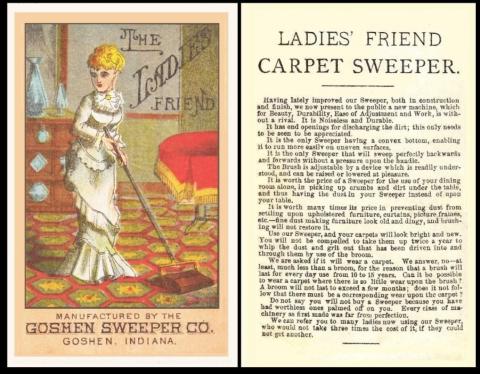
GOSHEN Sweeper Company [trade : carpet sweepers : O/S - Goshen, Indiana] "Advertising Card" (1890) 1/1
Moving on to another invention, today, in 1869, saw U.S. Patent No. 91,145, for "an improved sweeping machine" granted to Ives W. McGaffey of Chicago.
The word "improved" is the important one, as there was already a kind of mechanised sweeper in existence, since the 1850s. This worked on a system of wheels and pulleys which rotated a brush that swept the dirt and dust around and caught it in a partially enclosed space.
Both these ideas are not too different from today`s vacuum cleaners, and they were, amazingly, not much different in looks today`s upright models, save for the size, because Mr. McGaffey`s improvement was to add a hand cranked, belt-driven fan. This actually made more work for the person doing the vacuuming than the previous machine had, but it was definitely an improvement in the mechanization of the process.
Sadly, just a few years later, almost all of his machines were lost in the Great Chicago Fire of 1871.
Now this card is not his machine, but oddly it borrows some of the wording from his patent, which speaks of the fact that using a broom or brush on a carpet is not only inefficient at removing dust and dirt, instead releasing it into the air or pounding it into the bottom layer of the carpet to lie unseen, but brushing away repeatedly will eventually damage the carpet, discolouring it, and making holes. Instead his machine breathed in the dust and dirt, and only let the air come out, and because it did that so efficiently one brisk run over the area was enough to clean it.
The next development was by Hubert Cecil Booth`s "Vacuum Cleaner Company Ltd", in 1901, this was a way larger machine, so big that it needed to be brought to the house in a horse drawn carriage, and once there, the dirt and dust was sucked out through massive hoses that were pushed through the open windows of the client`s home. As you may imagine that did not meet with public success - but it was remembered, for you can see it on card no.40 of Brooke Bond`s "Inventors & Inventions" (1975).
Then, in 1907, James Murray Spangler, a janitor, who was also a salesman and an inventor had a breakthrough. He knew, as a janitor, that people did not want to lug round heavy machinery, not have to get someone else in to do the work for them. Most importantly, he suffered from asthma, and knew the effect of what sweeping with a brush had on him. So in his spare time he worked on making a light, easy to carry, and easy to use cleaner, that was powered by an electric motor. to revolutionize the vacuum into a model similar to what we use today. He was also far sighted enough to make it have a removable bag, so that you did not have to take the whole machine outside to empty it, and, to prolong its life, he developed a range of tools and devices that would allow a homemaker to keep it clean and in good working order. His patent was granted in 1908, and he even formed the Electric Suction Sweeper Company to make and sell his device.
His undoing was that he did not have a lot of money, and he needed backers. The first people did not work out so well, they pulled out when the machine did not seem to be showing a quick turnover, nor much of a profit. Then things got really bad, and he could not afford to make more machines. He kept tinkering away, hoping to make it more saleable, and one day he had both a stroke of luck and the beginning of the end, for he showed his machine to his cousin. She loved it, and told her husband. He agreed to go in partnership with our man, on one condition, that being that the name of the company was his. And so began the Hoover Suction Sweeper Company. By the end of 1908 he had bought Mr. Spangler`s patent and all the rights, and he also created a buzz about the machine, so much so that his staff were soon making six machines every day. Not just that but he knew the power of seeing the machine working in an actual home, and so he allowed any prospective new customer to take one home for ten days and try it out for free, during which time one of his salesmen would visit the area and drum up more business.
Strangely the Brooke Bond card mentioned above seems to be the only one to show a vacuum cleaner. Though there are plenty of early American advertising cards like ours, and another line to investigate is playing cards, there are several packs, a quick look on an internet auction site found various styles, especially issued by Hoover, including a super pack showing the Art Deco headquarters along the Western Avenue heading into London).
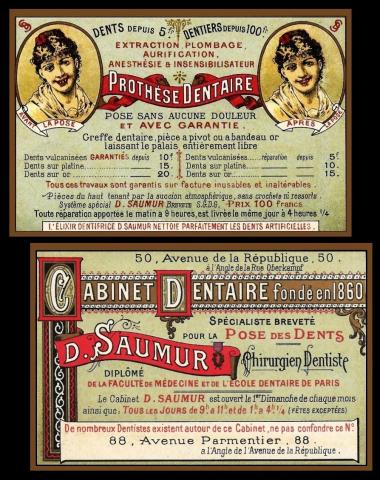
D. Saumur [trade : dentistry : O/S - Paris, France] "Advertising Card" (????) 1/1
Today, in 1822, supposedly changed dentistry for ever, as Charles M. Graham, of New York, patented "porcelain teeth".
This does not fit too well though, as he was not actually the first to patent false teeth, that was Nicholas Dubois De Chemant in 1791. And more than that, Monsieur de Chemant`s artificial teeth were also made of porcelain, suggested by his partner, Alexis Duchateau, who, coincidentally or not, lived in Sevres, a renowned centre for the manufacture of that material.
As often occurred, though, the partnership soon dissolved in furious flames, both men claiming to have had the idea and wanting to have the lion`s share of the fame and profits. And after some bitter acrimony, the courts upheld the patent awarded to Monsieur Du Chémant.
Then, not so long after, the French Revolution starts, and he flees to England, where he also applies for a patent. This leaves him holding both the French and English patents for artificial teeth.
And you can read his book, "A Dissertation on Artificial Teeth", published in 1797, online.
You may be wondering, well, what happened before this, so let me tell you that there were already artificial, as in "not your own" teeth, but they were not so palatable. The "best" ones were made of painted wood, or of ivory, though that browned and yellowed. But you could also get cheaper teeth, "borrowed" from deceased humans (especially during the battlefields in the American Civil War, when local dentists would wander down after the skirmish was moved on and extract away with abandon). Some dentists also used the teeth of deceased animals.
No wonder porcelain teeth had such an appeal.
Returning to Charles M Graham, it seems likely that he held simply the first American patent, but why he should have become so well known I have no idea. Maybe it was simply the power of advertising.
Now I cannot find D. Saumur of Paris, but he was founded in 1860, and this card offers single teeth from five cents each and dentures from a hundred francs. The single teeth could be made of rubber (ten francs), platinum (fifteen francs) or gold (twenty francs). Not sure what you would get for five francs, maybe it was better not to ask. He also offered to repair teeth for five cents less in each case.
I will keep looking and report back.
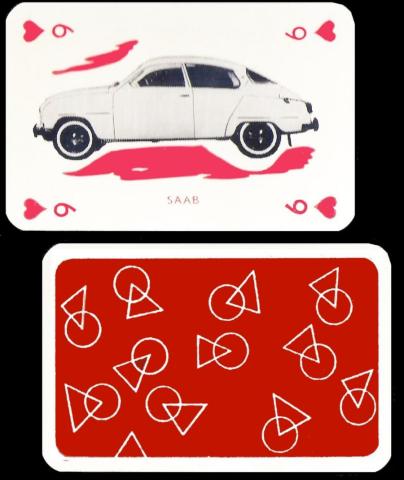
MONTY [trade : gum : O/S : Netherlands] "Motor Cars", playing card inset (1956) - six of Hearts
More inventions, for today in 1947 work started on the "Ursaab", or prototype car. This would eventually become the Saab 92, but not until December 1949.
Now Saab were founded in 1937, but there is a twist to this as, more properly, "SAAB" is an acronym, for Svenska Aeroplan Aktie Bolaget - or The Swedish Aeroplane Corporation.
The founder was another company, and a familiar name to military historians, as it was Bofors, and they go way way back to 1646, though they really only started in the defence industry in 1883.
The beginnings of SAAB came by their combining a company which formerly only made aircraft engines with a company that made aircraft, and then producing the aeroplane and the engine as one saleable unit. That was in 1937, just in time for the Second World War to act as a test bed.
In fact you will find several cards of their aeroplanes, mostly the Draken - one is on card 21 of Barratt`s "Modern Aircraft" (1957), and another on card 55 of Master Vending`s "Aircraft of the World" (1958).
Our card was issued before both of these, and it is, so far as I know, the first card of a Saab motor car ever to have been produced. Unless you know of others. This pre-dates the other cards that are often said to be Saab`s car`s "Rookie" card, namely Priory Tea`s "I Spy Cars" (card 42, issued in 1963), or Lyons Maid`s "Famous Cars" (card 32, issued in 1965).
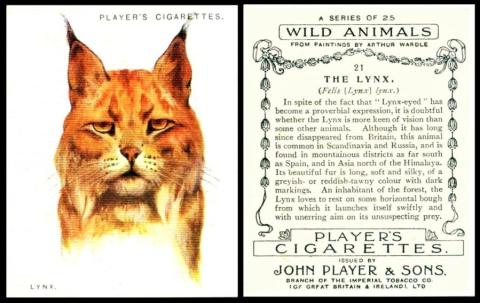
John PLAYER & Sons [tobacco : UK] "Wild Animals" (1932) 21/25 - P72-141 : P/196.C [RB.17/196.C]
Breaking with all these inventions, today we celebrate a fine feline from the natural world, the Lynx - on #NationalLynxDay
There are four distinct species of lynx, in different areas of the globe. These are the Canada Lynx, the Iberian Lynx of Spain and Portugal, the Eurasian Lynx of Europe out as far as Siberia, and the American Bobcat. Researchers believe that the species is of an age that all would have roamed together, then become separated when the continents divided, at the very dawn of time.
As for the name, well that is Greek, and it refers to the strange lightness of its eyes. Today we know that this is because they are reflective, just like pet cats, and it is due to the tapetum lucidum, which is a layer at the back of the eye which helps them see in the dark, as well as making their eyes stand out brightly at night.
In many other ways too, lynx are cat-like, though their tails are shorter, and they have an odd fluffy bit of black hair on the tips of their ears. In addition, many of the species have adapted to their surroundings, those who live in snow having developed larger paws with extra padding to prevent the cold affecting them. Native dogs, in the same areas, do this too. But oddly humans cannot, we just have to wear more clothes, and boots with thicker soles.
There are plenty of cards showing lynx, but this is is an especially attractive one. The earliest card known shows the Canada Lynx, and it is part of a set of thirty "Animals of the World", which, it tells us on the cards, was copyrighted, by Abdul Cigarettes, in 1881, so presumably issued a short time after. However, the exact same picture also appears in the set of "Quadrupeds", both the cards and the printed booklet, as issued by Allen and Ginter in 1890. And it is also used by Philadelphia Caramels for their set of "Zoo", in 1909.
Our card is available in four formats - which are described in our original John Player reference book (RB.17, published in 1950) as :
- 196. WILD ANIMALS or WILD ANIMALS HEADS. From paintings by Arthur Wardle. Fronts in colour. Backs in grey. Home issues.
A. 50 Small cards, titled "Wild Animals` Heads". Backs with descriptive text. Issued January, 1931, in Northern Ireland only, elsewhere in UK in June, 1931.
B. Small unnumbered transfers. Backs with instructions for use.
1. Inscribed "Transfers - Wild Animals` Heads". 25 only
2. 50. Inscribed "Transfers - A Series of 50 -Wild Animals` Heads"
C. 25 Large cards, titled "Wild Animals - A Series of 25". Issued July, 1927.
D. 25 Large cards, titled "Wils Animals - 2nd Series of 25". Issued December, 1932.
Similar series issued by Wills.
I will explore the Wills issue elsewhere, some time in the future.
I ought to also add that the small sized Player set, and presumably the transfers, are the same picture but numbered differently (as card no.36).
In our original World Tobacco Issues Index, the above is not that dissimilar. The entry, under Player section 2, for "Issues with I.T.C. Clause" sub section B, for "issues 1922-1939" reads :
196. WILD ANIMALS or WILD ANIMALS HEADS. See RB.17/196 ... P72-141
- A. Small cards.Titled "Wild Animals` Heads". Nd. (50)
- B. Small transfers. Titled "Wild Animals` Heads". Unnd.
(a) Without "Series of 50" (25)
(b) Inscribed "Series of 50" (50)
- C. Large cards. Titled "Wild Animals". Nd.
1. "A Series of 25".
2. "2nd Series of 25".
There is no mention of the Irish version, so it must have been identical to the home one.
And there is also no word that the set was also issued by W.D. & H.O. Wills.
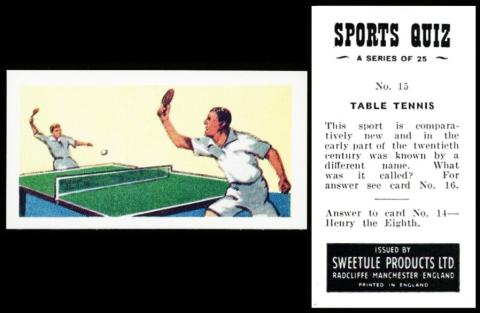
SWEETULE Products Ltd [trade : confectionery : UK - Manchester] "Sports Quiz" (1958) 15/25 -
Ooh, a Centenary - they have been a bit thin on the ground of late.
Anyway, today, in 1925, saw the birth of Richard "Dick" Theodore Miles, American ten-time United States National Table Tennis Champion, his first being in 1945 and his last in 1962.
He was born in New York, and whilst he was still an infant his father left. His mother pretty much brought him up on her own, and made sure he never felt neglected. When he was ten years old, someone bought him a table tennis set, and he loved it, spending hours perfecting all kinds of shots, though often it was only him against the wall. Though there is a theory that this only increased his ingenuity and skill. Within a few years he was a regular at many sporting clubs, anywhere that had a table and someone to play. He would frequently skip school, and later failed to finish his studies at New York University.
Despite his speed at the table he was denied a chance to serve in the United States Army when a routine medical discovered a heart murmur. He tried to appeal, with no luck. Instead he stayed in America, and played table tennis with anyone he could find, making money on the side by betting on, or against, himself to win.
Most table tennis historians agree that despite his ten American Championships, his best ever result was reaching the semi-finals of the World Championships in 1959, a feat made all the more impressive by the fact that he beat two of China`s top players to get there. No American male player, to this day, has ever reached the finals of that event.
After that he wrote a book on how to play the game, and kept up his appearances on what is rather unfairly called the "trick circuit", for successfully playing such a range of unusual and exciting shots can only be done by a highly skilled player.
He also started a company that imported table tennis equipment from Asia, the leading manufacturing company of such things in the world.
He died in New York, aged eighty-five. And, strangely, his cause of death was marked on his certificate as purely down to natural causes; there was no sign of the heart murmur which had prevented him serving his country.
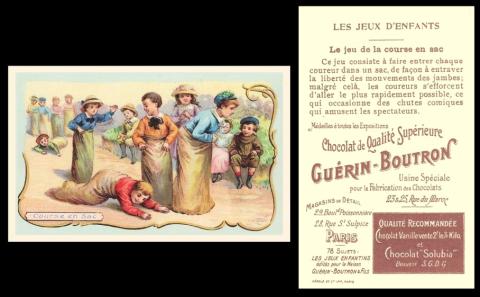
GUERIN Boutron [trade : chocolate : O/S - Paris, France] "Les Jeux Enfantine" (19??)
And lastly, one of the mo"st curious tales I have ever brought you.
Before the expansion of the U.S. Postal Service into the more rural areas, mail was only delivered by hand, one local to another, or news by word of mouth, and goods could not be bought in shops and forwarded by parcel unless they weighed less than four pounds in imperial measures.
Then, on January the first, 1913, parcel post expanded right across America, and they raised the weight limit to eleven pounds. This meant that anyone could post anything so long as it was below that weight.
And "anything" turned out to be the right word, for just a few weeks after the Parcel Post began, a couple from Ohio turned up with their eight month son, and mailed him to his grandmother, who lived a mile away. The couple had worked out that he was just below the maximum weight allowed for a parcel, and sending him on the train would have cost more than the fifteen cents they were charged to post him. Reportedly they did insure him, against non-delivery, just in case - valuing him at fifty dollars.
He was not sealed up in a parcel, by the way, he was just sitting in a mail bag, with the address and postage stuck on the side, and reportedly he was made a fuss of all the way along.
Now when the story was discovered, it made the headlines in all the papers, simply to shock people with the awfulness of the event. Instead it had the opposite effect, and lots of families with small children thought hey, that`s a great idea, we can do that as well, save some money..
And there were enough of them sent that today, in 1920, the United States Postal Service ruled that they would no longer accept children sent by mail.
Our card is a bit of a tangent, but it is a child, or several children, (each) in a sack. This is one of 78 subjects depicting children`s games, all of which have the elaborate scroll edge and gentle colouration, and soon there will be a list below of the ones I know of.
Not tonight though because the scan of the card of the teeth has only just arrived and I have to make that into a pair.
This week's Cards of the Day...
told of a rather an unusual tale, for on the 5th of June it would be the hundred and twenty-seventh birthday of Salvatore Ferragamo.
He was born in 1898, and was a shoemaker, though of rather more grand and wonderful shoes than the ones that most of us walk about our daily lives in.
You would not believe, then, that he was born to a very poor family, one of fourteen children. He reportedly made his first pair of shoes aged just nine, and immediately announced that this was where his future lay.
Saturday, 31st May 2025
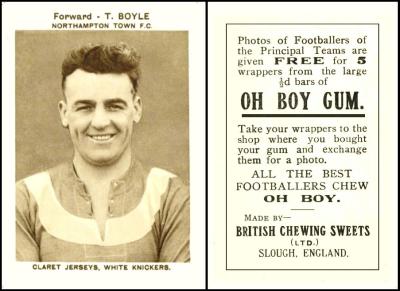
This clue was rather prosaic for Mr. Ferragamo`s shoes, for it referred to the fact that a shoemaker is also known as a cobbler, and Northampton Town`s nickname, since their beginning in March 1897, is "The Cobblers".
As to why, well boot and shoe manufacturing was the town`s main industry, was a major employer for many years. You can see that on both John Player`s "Counties and Their Industries" (1915) and Pattreiouex`s "The English & Welsh Counties" (1928)
The footballer on our card is Thomas Boyle, and he was born, in Sheffield, on the 21st of February 1901. He grew up to become a miner, but was spotted, aged twenty, playing football for the Bullcroft Colliery team, and signed for Sheffield United.
Almost certainly his proudest moment was lifting the F.A. Cup with them, at Wembley Stadium, just four years later in 1925. And his dad was probably just as proud, for he was the Irish international Peter Boyle, also of Sheffield United, who had won the F.A. Cup trophy himself, with them, in 1899 and in 1902 - and also played in the 1901 final, which was won by Tottenham Hotspur.
According to the Trading Card Database, Peter Boyle is on just two cards, the 1901 set of F. & J. Smith "Footballers" (No.80) - and the 1902 set of Ogden`s "General Interest" (No. F.375).
His son, and our man, listed as Tommy Boyle (b,.1901), seems to appear on a few more cards. The first is a cigarette card, the 1912 set of Murray`s "Cricketers and Footballers Series H" (unnumbered), but that cites Burnley, so it is almost certainly of the other Tommy Boyle, born in 1886. The trade card, the 1925 Crescent Confectionery "Footballers" (unnumbered), is definitely him, with Sheffield United. Our card is not listed. As to the later cards listed, the 1997 reprint of the 1914 Churchman "Footballers" is also the other Tommy Boyle. And I have no idea who is on the two J.F. Collectables cards, for they are only listed not shown - but if you own them please tell us the team so that we can add or discount them.
In 1929 our man moved on, to Manchester United, for £2,000 - that equates to approximately £105,000 today. However he was only there for one season. Something must have been going on then, as he moved to Macclesfield and within a month or so was at Northampton Town. He either liked that better, or the problems elsewhere had settled down, as he stayed for five years.
After that he did a little bit of player-managing for Scarborough, and also took over the license of the Plough Inn, which was at Scalby, not so far away. He died in January 1972, aged seventy.
This set first appears in our original British Trade Index, RB.25, published in 1962, as :
BRITISH CHEWING SWEETS (LTD), SLOUGH, BERKSHIRE
Cards exchanged for wrappers from "Oh Boy Gum", about the 1920s.
- PHOTOS OF FOOTBALLERS OF THE PRINCIPAL TEAMS. Md. 75 x 51. Brown varnished half-tones. Unnd. (3 known) ... BRI-1
1. Half Back - A. Turner - Stoke City F.C.
2. Forward - Bourton - Coventry City F.C.
3. Goal - A. Todd - Port Vale F.C.
That obviously, dare I say, set the ball rolling, for in the British Trade Index part two, RB.27, published not so long after in 1969, the trio is now forty-seven strong. Now this listing again numbers the cards, though they are unnumbered in actuality. That means our numbers 1, 2 and 3 above are now moved to being numbers 36, 39 and 12. However, I have retained the numbering in this instance, and the entry reads, exactly :
BRITISH CHEWING SWEETS. BR1-1 (PHOTOS OF FOOTBALLERS). 47 known : -
- A. Matt front, 7 known. Nos. 3, 6, 10, 14, 22 36 and 46.
- B. Glossy Front. 45 known. All except Nos 6 and 46.
Goal :
- T. Crilly, Northampton Town
- J. Cunningham, Walsall
- A. Dexter, Notts Forest
- Ellis, Wolverhampton Wanderers
- L. Hammond, Notts County
- W. R. John, Stoke City
- J. Kirby, Derby County
- A. McLaren, Leicester City
- Moody, Chesterfield
- Pearson, Coventry City
- H. Pearson, West Bromwich Albion
- A. Todd, Port Vale (was No.3, above)
- C. Williams, Mansfield Town
Back :
- J. Barrington, Notts Forest
- S. Bird, Walsall
- Bilsby, Coventry City
- Black, Leicester City
- A. Brown, Northampton Town
- England, Mansfield Town
- Hamilton, Chesterfield
- Lowton, Wolverhampton Wanderers
- R. McGrory, Stoke City
- G.H. Poyser, Port Vale
- G.E. Shaw, West Bromwich Albion
- G, Stimpson, Notts County
Half-Back :
- J.W. Barker, Derby County
- L. Butler, Mansfield Town
- Davison, Coventry City
- J. Dowsey, Northampton Town
- T. Graham, Notts Forest
- Rhodes, Wolverhampton Wanderers
- W. Richardson, West Bromwich Albion
- Ritchie, Leicester City
- J. Round, Port Vale
- Sliman, Chesterfield
- A. Turner, Stoke City (was No.1, above)
Forward :
- Adcock, Leicester City
- Bedford, Chesterfield
- Bourton, Coventry City (was No.2, above)
- T. Boyle, Northampton Town
- S. D. Crooks, Derby County
- Deacon, Wolverhampton Wanderers
- W. Dickinson, Notts Forest
- Mill, Mansfield Town
- T. Nolan, Port Vale
- W.C. Richardson, West Bromwich Albion
- G. Taylor, Notts County
At this point I have to mention something that you probably also picked up on, for it seems very odd that here we have a company based in Slough, in the southern half of England, not that far from London, and yet these football teams are all northern ones.
The inclusion of Chesterfield may also seem rather odd in a set of Principal Teams, but wait, for they were champions of the Midland League in 1919-20, albeit as Chesterfield Municipal - they were not named simply Chesterfield until the end of 1920. Their best ever League result is stated to be fourth, in the Second Division, in the 1946–47 season, though they did make the semi finals of the F.A. Cup in 1997, before being being knocked out by Middlesborough.
I digress, once more.
This is the last appearance of this set in our original British Trade Indexes.
They next appear in our updated British Trade Index, published in the year 2000, with a second issue. as :
BRITISH CHEWING SWEETS (LTD), SLOUGH.
Issued 1930s with "Oh Boy Gum".
- FILM STARS (A). About 35 x 20. Plain back. Name of star plus Film Co. in small letters, base of front. Unnd (22 known). See HB-169. Anonymous ... BRI-440
- PHOTOS OF FOOTBALLERS OF THE PRINCIPAL TEAMS. 1933/34. Brown varnished half-tones. 75 x 51. Unnd. (60). Four players from each of 15 teams. See HB-170. Each card given in exchange for five wrappers. ... BRI-450
This entry omits any reference to the fact that the cards can be found in matt and/or gloss, but maybe it has been discovered that all can be obtained in both formats? As for the "HB" code, that sends us to the handbook for this volume, to where the lists of unnumbered cards were removed - in order to save space in the index, and also to keep it to a manageable size. The footballers are again numbered, though, and, confusingly, they in yet another different order, omitting their positions entirely.
This entry, complete with notes to changes of text, and including the former numbers, therefore reads :
HB-170. PHOTOS OF FOOTBALLERS OF THE PRINCIPAL TEAMS. Unnd. (60). Issued by British Chewing Sweets. See BRI-450.
- Adcock, Leicester City (was No.37)
- Allsop, Walsall (new discovery)
- D. Astley, Aston Villa (new discovery)
- E. Barkas, Birmingham (new discovery)
- D. Blair, Aston Villa (new discovery)
- J. Barker, Derby (was No. 26, entered as "J. W. Barker, Derby County")
- J Barrington, Notts. Forest (was No.14)
- Bedford, Chesterfield (was No.38)
- S. Bird, Walsall (was No.15)
- Bisby, Coventry (was No.16, entered as "Bilsby, Coventry City")
- A. Black, Leicester City (was No.17, entered as "Black, Leicester City")
- Bourton, Coventry (was No.39, entered as "Bourton, Coventry City"
- T. Boyle, Northampton (was No.40, entered as "T. Boyle, Northampton Town"
- J. Bradford, Birmingham (new discovery)
- A. Brown, Northampton (new discovery)
- I. Butler, Mansfield Town (was No.27, entered as "L. Butler, Mansfield Town" - but that may have been my eyes, will check)
- T. Cooper, Derby (new discovery)
- T. Crilly, Northampton (was No.1, entered as "T. Crilly, Northampton Town")
- S. Crooks, Derby (was No.41, entered as "S. D. Crooks, Derby County")
- J. Cunningham, Walsall (was No.2)
- Davison, Coventry (was No.28, entered as "Davison, Coventry City")
- Deacon, Wolves (was no.42, entered as "Deacon, Wolverhampton Wanderers")
- A. Dexter, Notts Forest (was No.3)
- W. Dickinson, Notts Forest (was No.43)
- J. Dowsey, Northampton (was No.29, entered as "J. Dowsey, Northampton Town")
- Ellis, Wolves (was No.4, entered as "Ellis, Wolverhampton Wanderers"
- England, Mansfield Town (was No.19)
- T. Graham, Notts Forest (was No.30)
- F. Grice, Notts County (new discovery)
- Hamilton, Chesterfield (was No.20)
- L. Hammond, Notts County (was No.5)
- H. Hibbs, Birmingham (new discovery)
- W. John, Stoke City (was No.6, entered as "W. R. John, Stoke City")
- J. Kirby, Derby (was No.7, entered as "J. Kirby, Derby County")
- C. Leslie, Walsall (new discovery)
- Lowton, Wolves (was No.21, entered as "Lowton, Wolverhampton Wanderers")
- R. McGrory, Stoke City (was No.22)
- A. McLaren, Leicester City (was No.8 - we now know that this is a picture of J. McLaren instead)
- Mill, Mansfield Town (was No.44 - and it is a typo, it should have read "Mee", Mansfield Town)
- Moody, Chesterfield (was No.9)
- G. Morrall, Birmingham (new discovery)
- H. Morton, Aston Villa (new discovery)
- T. Nolan, Port Vale (was No.45)
- J. Palethorpe, Stoke City (new discovery)
- Pearson, Coventry (was No.10, entered as "Pearson, Coventry City")
- H. Pearson, West Bromwich (was No.11, entered as "H. Pearson, West Bromwich Albion")
- G. Poyser, Port Vale (was No.23, entered as "G.H. Poyser, Port Vale")
- Rhodes, Wolves (was No.31, entered as "Rhodes, Wolverhampton Wanderers")
- W. Richardson, West Bromwich (was No.32, entered as "W. Richardson, West Bromwich Albion")
- W.G. Richardson, West Bromwich (was No.46, entered as "W.C. Richardson, West Bromwich Albion" - possibly my typo, will check)
- Ritchie, Leicester City (was No.33)
- J. Round, Port Vale (was No.34)
- G. Shaw, West Bromwich (was No.24, entered as "G.E. Shaw, West Bromwich Albion")
- Sliman, Chesterfield (was No.35)
- G. Stimpson, Notts County (was No.25)
- A. Talbot, Aston Villa (new discovery)
- G. Taylor, Notts County (was No.47)
- A. Todd, Port Vale (was No.12)
- A. Turner, Stoke City (was No.36)
- C. Williams, Mansfield Town (was No.13)
Sunday, 1st June 2025
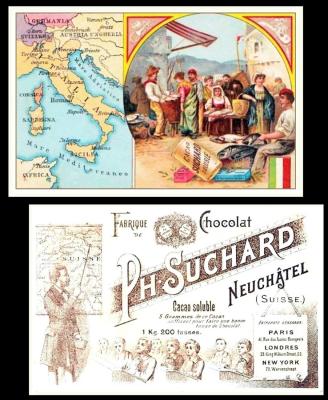
So here we have Italy, the birthplace of Salvatore Ferragamo. And now the story really begins, for he was born on the 5th of June, 1898, in Bonito, Campania, Italy, to a very poor family, despite which he was the eleventh child. And three more children were born after him.
We know very little about his early life, only that he was fascinated by shoes from a young age, and made his first pair of high heels at the age of nine, which were for his sisters to wear at their confirmation. This fact suggests that the somewhat large size of the family could well have been due to multiple births.
Anyway he so enjoyed constructing the shoes, and remodelled them several times before he accepted they were ready, that he then announced he wanted to be a shoemaker when he grew up.
This seems to have been accepted by his family and he never wavered from this decision, so when he was only thirteen he was sent off to study shoemaking in Naples. That was the centre of the craft, and it specialised, then and now, in making the shoe fit the foot - and not the other way around as was more usual. This meant that as part of the training the students had to study the form of the foot.
When he was fourteen he returned home, and opened a shop, in part of his parents` home. This was, almost certainly, discussed by the locals, and it must have brought him quite a bit of custom from them, which expanded when they realised that yes, he was young, but also he knew his craft.
This is yet another back for Suchard, but this is a larger card than many of those we have featured before. And the back is extraordinarily lightly printed - but I will have another go, at getting it more visible.
As for a date, that is based on the fact that the Suchard branch in New York, mentioned on this card, was opened about 1901.
I do not know how many complete this set, though those found so far suggest it may be twelve. For one thing, Switzerland, the home of Suchard, is not there. Also, no France. With those, it is eleven.
Again I will number them, to make it easier, but when no more can be found it will revert to a bulleted list - unless someone knows that these cards are numbered, and where!
The ones I know of so far are
- Allemagne [Germany]
- Angleterre [Great Britain]
- Autriche-Hongrie [Austria-Hungary]
- Belgique [Belgium]
- Italie [Italy]
- Nederlande [Netherlands]
- Russie [Russia]
- Sverige [Sweden]
- Turquie [Turkey]
Monday, 2nd June 2025

Now this set is not titled, but above the mask it says "La Veine", which translates to vanity. Whilst that is not strictly a deadly sin in either French or English - the list being l'orgueil (pride), l'avarice (greed), l'envie (envy), la colère (wrath), la luxure (luxury, or lust), la gourmandise (gluttony), and la paresse (sloth), respectively - it is definitely related.
Many of these things also relate to expensive shoes (etc), the pride or showing off in wearing them, the greed of stealing or making money by unfair means to afford them, the envy and wrath some people feel towards anyone with more beautiful things, the feeling of luxury to the wearer, and the gluttony, perhaps, if they are not satisfied with the one single pair.
However the card was actually picked because the person shown is not just a beauty, she is, or was, a celebrity, and though Mr. Ferragamo himself may not be seen as such, there is no denying that for the most part it is only celebrities who wear his finest creations.
Her name was Marcelle Lender, and she was an actress and dancer. More than that, though, she was a great favourite of Henri de Toulouse-Lautrec, whose most famous painting of her is called "Mademoiselle Marcelle Lender, Bust-Length", and it was painted in 1895, just six years before his death, at the age of thirty-seven.
That was the year that she starred in a revival of the operetta, "Chilperic", at the Theatre des Varietes, which he attended more times than anyone could count, and possibly more times than he revealed to any of his friends. She played the part of a Visigoth princess, called Galeswinthe, and, for whatever reason, during the performance she danced the bolero, clicking away rapidly with a pair of castanets. She hardly ever faced the audience, but Toulouse-Lautrec was able to recall the moments that her face shone towards him, and, unusually, she is the only one of all his subjects whose representation may be termed a proper portrait, rather than a caricature or impression.
We do not, and probably will never know why he was so attracted to her. She was neither young, nor slim, but she had something which completely captivated him. Perhaps it was her freedom, her spirit. Or perhaps, simply, because of her brilliant orange hair, which she whirled freely whilst dancing; hair made even more orange by the fact that she artificially lightened her facial complexion.
As for our issuer, Lefevre-Utile, they are still a household name, though you may know them better as "LU". One of their best known brands are the original "Petit Beurre"
They were originally made in France, in Nantes, in 1846, by a patissiere, Jean-Romain Lefèvre, who sold cakes and biscuits.
In 1850, he married Pauline-Isabelle Utile, and the name of the shop changed, to Lefevre-Utile, a combination of their surnames. She was obviously a very modern and forward thinking bride who decided to keep her own name rather than be subsumed into taking his instead.
However the first time the company name appears on any advertising was in the late 1890s. Now this may be something to do with the fact that although he sold biscuits, he did not make them - instead, he imported them, from England, from none other than Huntley and Palmer. Then, as you do, perhaps with a wifely nudge or two, he wondered how hard it would be to make his own. Obviously it was not so tough, because he stopped importing them.
Now Pauline-Isabelle Utile was actually from Nantes, whilst Jean-Romain Lefevre came from Meuse. They had four children, Ernest, the oldest, who was born in 1851 and died at the start of the Second World War, Auguste (about whom nothing is known save his birthdate of 1854), Pauline, named after her mother, who was born in 1855 and died relatively young at the age of thirty nine, and Louis who was born in 1858 and also died during the Second World War, in 1940. However he was the one who inherited the company, in 1882, after the death of his father - and he was also the one who actually invented their best selling line, the "Petit Beurre"
Pauline Lefevre-Utile lived on for quite some time and only died in April 1922, still in Nantes, aged ninety-one.
Tuesday, 3rd June 2025
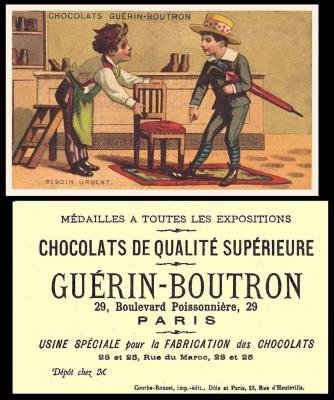
Here we have a shoe shop, but not just because of Salvatore Ferragamo`s first venture at his parents` home.
For in 1915 he emigrated to America, to Boston, to join one of his brothers who was living there, and working, coincidentally, or not, in a factory making boots. Salvatore loved making the boots, but not the factory atmosphere, and so he moved on, to California. He then suggested that his brothers move there too, which they did.
Once there, it is often said that he opened a shoe shop, called the Hollywood Boot Shop. However this is slightly incorrect, as his first shop, a shoe repairers was in Santa Barbara, and he had operated that for seven years before he got the option of leasing the Hollywood Boot Shop, at 6687 Hollywood Boulevard, which was already operating under that name. He bought the shop outright in 1923.
When he leased it, he also took on its clientele and its reputation, which was considerable, as it was one of the oldest shoe shops in the area, formerly operated by Morgan and Stoll, and more recently run by J. M. Bohannon.
In addition, they were already making shoes for the movies.
The first pair of Salvatore Ferragamo’s shoes to appear in the movies were made in 1923 for Cecil B. DeMille’s epic, “The Ten Commandments”. This was filmed all around Santa Barbara, with the scene of the parting of the Red Sea being shot at Seal Beach. It was not filmed as live action, by the way, the parting of the waves was one take, as a model, and the scenes of the people walking through the parted waves was superimposed later.
However from this tiny beginning came his fame, and his nickname, "Shoemaker to the Stars" - though it is suggested that he designed the nickname rather than waiting for it to be given. We do know that one of his best clients was Rudolph Valentino, who had all his shoes made there after the first pair had fitted so well. He had quite high arches, and he would have much appreciated the comfort of having shoes specially made to compensate for this. And remember that Salvatore Ferragamo had studied anatomy in Naples at the age of thirteen. More than that though, he had gone back to school, at the University of Southern California, to again study anatomy, at a higher level.
Then, in 1927, Ferragamo upped and left, returning to Italy. He based himself in Florence. Some wonder why this occurred, but his time in the United States was always going to be temporary. He went there to learn, to work in a factory, and then to broaden out into a shop. This he had done, with great success. But he also realised that the American way, of making shoes by machines, to fit everyone, was not his way. And at home he would find many more skilled craftsmen who he could charge with making his shoes, made to measure, by hand - plus young Italian men, whom he could teach. He knew that would never be possible in America.
Unfortunately his dreams briefly flickered and almost died, and though he had a large list of American contacts, the distance was too great, the costs of shipping a small quantity of hand made shoes too expensive, and he filed for bankruptcy in 1933.
He pondered for quite a while on the idea of his returning to America, but eventually decided against it. For one thing, he met a local girl, the daughter of his family`s doctor, and he married her in 1940, when she was only eighteen. They had six children, and she became the head designer for the Ferragamo company. And so he stayed in Florence apart from short trips, for important things, like opening his New York Branch in 1948.
His marriage brought him peace and the chance at a new beginning. Also there was another second chance, which fell right into his lap, and that was the Second World War, for as it progressed, and more and more shoe making materials became unavailable, his skill at working with the more unusual came flooding back, and he was one of the few people to still be making shoes - from things that nobody else would have imagined, soles and heels made from cork, using dyes to take the place of the now hard to get coloured fabrics and leathers. In fact he also invented the "wedge" heel, which distributed the weight of the foot right along the sole, invaluable for ladies who were working in factories all day long on war work. Also, after the war, he did not have to wait until the formerly rationed materials came back, so his staff and name expanded rapidly, and his former contacts started to return.
And, in one of his greatest coups, he managed to make a pair of shoes for Marilyn Monroe.
He died in 1960 at the age of just sixty-two. His wife took over the company, and ran it for over twenty years, slowly handing over the responsibilities to their children. She also added new lines, and moved into fashion, and handbags, not just shoes. She died in 2018, aged ninety-six.
To our card, and there is a very interesting name on it, the printer, Courbe-Rouzet, of 23, Rue d`HauteviIle, in Paris. They also did printing for Liebig, and many others. Pierre Joseph Courbe was born in November 1831. At first he was destined to be a stonemason, like his father, but he turned the carving of stone into the carving of lithography. In the 1860s he met a man called Robelin, and they briefly teamed up. They printed labels, for the most part, for boxes of all kinds, from large packing crates to matchboxes. This soon expanded into advertising and trade cards.They seem to have parted on good terms though, as the patent was split between them. It appears that Robelin was simply moving to another location.
Courbe then opened a business under his own name at 142, Boulevard Saint-Denis, in Paris; this operated from 1879 until 1883, and then he moved to Rue d'Hauteville. He also got married in the 1890s, which is when the company name changed to Courbe-Rouzet. He died in 1912, but his nephew, Charles Rouzet, took the business over. It was closed in 1928.
I am not sure how many are in this set, but possibly two are left to find. The ones I do know, so far, are :
- Besoin Urgent [urgent need for mending - boy points down at shoe]
- Ca Va Comme un Gant [it fits like a glove - boy seated, leg on shoemaker`s lap]
- Pas de Place pour les Durillons [there is no unwanted space which forms calluses - boy stands on one leg showing sole to shoemaker]
- Preuve de la Soustraction [proof of subtraction (?) - shoemaker holds pair of boots, lower leg of boy running away out of right hand side of frame]
Wednesday, 4th June 2025
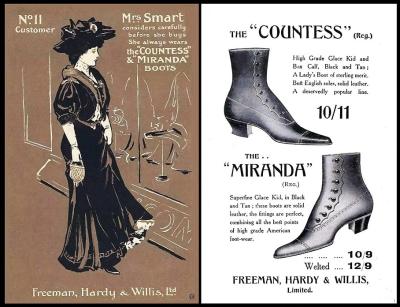
Keeping with our luxury theme, here is an elegant lady looking at "Countess" boots. However this was a British manufacturer, Freeman, Hardy and Willis founded in 1875, and still operating, though under new management and only in online store form.
The company actually started in Leicester, in 1870, as Edward Wood and Company, and he was purely a boot and shoe manufacturer, not a retailer. Within six years he had made enough money and prestige to become a limited company. To do this, he needed directors, and chose three men. These were Mr. William Freeman (his factory manager), Mr. Arthur Hardy (an architect) and Mr. Frederick Wills (one of his commercial travellers). For some reason Mr. Wood chose not to have his own name in the company, but he was the overall chairman thereof.
Mr. Freeman and Mr. Wills seem to have left fairly quickly, and quite permanently, there are records that both partnerships were dissolved - even before it was decided that the company was to become a shoe retailer rather than a manufacturer. That was in 1897. Their first branch was in Wandsworth, London, and they would eventually be able to claim in their advertising that they had a branch in almost every town.
There is some confusion over Mr. Hardy. Most records satet that he stayed for a long time after this, right into the 1940s. However this is incorrect. Our Mr. Hardy was born in 1846 and died even before Mr. Freeman and Mr. Willis left - in 1891. But his directorship was then assumed by his son, confusingly also called Arthur Hardy, born in 1878, and died in 1949. After that, his son, who was called Hugh, born in 1910, took over, but the last record I can track down has him still alive in 1939, then he disappears, though elsewhere it says that he was still involved with the business until the mid 1950s, even getting to see a large new headquarters open in Leicester - though this was not through expansion, it was to replace the former headquarters, and a huge proportion of the stock in hand, which had been destroyed by a bomb in 1940.
Whilst all this was going on, the firm had actually been bought out by the American company Sears, in 1929 - who are responsible for the name change that ousted the ampersand, and sometimes even abbreviated it to simply "FHW". From the mid 1950s, they ran the shops under the aegis of The British Shoe Corporation, until the early 1990s, when almost half of the shops were renamed as "Hush Puppies" stores and the other half sold. This did not work out so well, in either case, and the British Shoe Corporation also failed, closing in 1998.
The online version is actually operated by a company called Gardiner Bros & Co (Leathers) Ltd - but I have not been able to determine their connection with the original company.
Freeman, Hardy & Willis Ltd cards first make their appearance in our original British Trade Index part three, with quite a multitude of cards. Our set appears right at the top, entered as :
- Advertisement Cards (A). 4 groupings .... FPMB-1
- 142 x 87. "Customer No.7 - The Mayoress - is not so young". No address.
- 138 x 95. "The Evolution of the Leviathon No.4 - The Great Eastern" - back with Lincoln address
- 157 x 65. River picnic scene, inscribed "Freeman, Hardy & Willis Ltd - For Boating Shoes"
- 126 x 98. "Heeling Out!" (football scene). Back with Hounslow address.
Now after a little bit of investigation we can confirm that both 1 and 2 above are actually part of longer sets.
Tomorrow I will add the record from our updated British Trade Index, where their code is FRE-040, it is not that different, our set not at all, but there are a few more cards added below number 4.
I can add a couple of new cards to our set though, namely
- The Mayoress - is not so young
- Miss Hygrade - wants something that will not wear out (Academy)
- Mrs. Smart - considers carefully before she buys (Countess and Miranda)
And if you know any more, or the boots and shoes featured on the back of the Mayoress, please do tell us.
Thursday, 5th June 2025
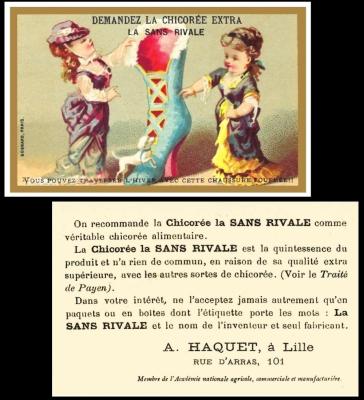
Another card of well dressed ladies admiring a boot - which, in this case, is way too big for them to wear. And there is also a spot of humour, see the little dog trying to run away with the laces, something dogs gain great pleasure from, and their owners let them get away with.
Now you will often find this maker listed as "Chicory Sans Rivale", but that just means the best chicory coffee - or, directly translated, chicory without rival.
The maker was actually A. Haquet, and he was based at 101 rue d'Arras in Lille. There is a suspicion that he was Jewish, as he made many chromolithographs on the Jewish way of life, but in a kindly way, not seeking to offend. We know he won gold medals at the exhibitions in Nice (1883 to 1885) and Amiens (1906).
Friday, 6th June 2025

We close our look at Salvatore Ferragamo with a name he would have known well, for this is Saint Crispin, the patron saint of cordwainers and tanners, as shown here, but also cobblers, glove makers, and saddlers - or, probably, more likely, the patron saint of leather-workers, as all these trades work with that material.
As to what a cordwainer is, well it is a shoemaker, but one who makes his shoes from brand new leather - whereas a cobbler repairs old or broken shoes, and if he cannot he breaks the leather down into parts and "cobbles" it together into a new pair of shoes, often in a smaller size.
There are actually two connected saints here, Crispin and his twin brother Crispinian.
They were Romans, who left their family to preach Christianity to the local Gauls, whilst, legend has it, repairing their shoes. They also repaired and made shoes for money, and gave that money to the poor.
However their goodly ways brought them to the attention of the local governor and he had them killed in 286 AD
This set was issued by many manufacturers, a quick course through the web finding :
- Chocolat d`AIGUEBELLE, Drome (chocolate) - descriptive text back
- De DROULERS Fils, Fresnes (chicory coffee and chocolate)
- Chocolat IBLED, Paris (chocolate)
- Paul MAIRESSE, Cambrai (chicory coffee)
- WIBAULT, Sin Le Noble (chicory coffee)
So there I must close, and head off into the darkness, to curl up and get some sleep, maybe. It may well be a rainy weekend, but if my back is not so bad I may try to go to the other Chiswick Market, the antiques one, along the High Street. That is on Sunday, if you are in the area.
Over the weekend, if it does rain, I will get the gen added in from the reference books and see what I can dredge up from the deepest recesses of the internet about things I mention above.
If anyone has any information, as always, on any of these subjects, please do contact us, at
webmaster@card-world.co.uk
Goodnight, now, wherever you are.....
